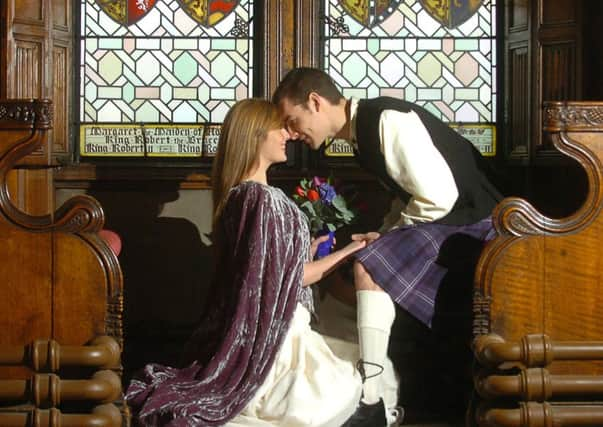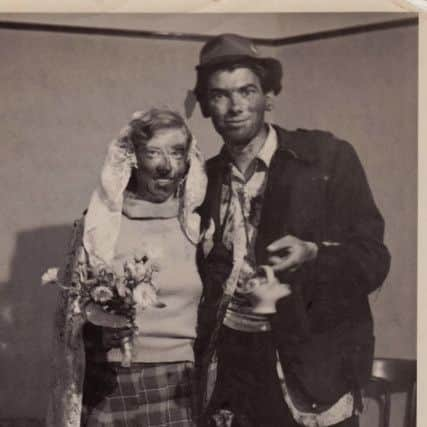5 old wedding customs of Scotland


Here, Elsie Maclean, of Tobar an Dualchais, a database of oral heritage recordings at Sabhal Mòr Ostaig, on the Isle of Skye, looks at five key customs of marriage through time. This article first appeared on Ms Maclean’s blog for Historic Environment Scotland.
The còrdadh
In Gaelic-speaking communities, a còrdadh (agreement) would be made between the bride and groom a few weeks before the wedding. This would take place in the house of the bride’s father.


Advertisement
Hide AdAdvertisement
Hide AdFriends of the bride and groom would also be in attendance and a series of ‘false brides’ would be brought in, often with humorous results, especially when they included married or elderly women. Food, drink and laughter would be in plentiful supply.
Flora MacCuish from the island of Berneray, in a recording for the School of Scottish Studies at Edinburgh University, earlier recalled a còrdadh she attended as a young woman in the 1920s.
At the event, a friend of the groom pretended that he was looking for a wife or a servant for a certain man.


The bride’s friends were each brought out and the groom rejected them all as unsuitable, until the bride herself appeared.
The rèiteach
Advertisement
Hide AdAdvertisement
Hide AdThe rèiteach, or betrothal ceremony, would take place a week or two before the wedding. This was an informal gathering where the father of the bride-to-be was asked to give consent for his daughter to marry.
In some areas, a friend of the groom would ask for the bride’s hand in marriage on behalf on the groom but the bride would be referred to, not as herself, but usually something related to the bride’s family’s trade.
If she was from a crofting family, she might be referred to as a lamb. The groom’s friend would promise to take care of the lamb and look after it well. This would all be done in a very good-natured way. After the bride’s father consented to the union, food would be served and this would be followed by singing and dancing until the early hours of the next morning.
Soot foot and blackening
Another custom undertaken prior to the wedding was feet-washing. Friends of the bride would wash her feet in a tender manner in a symbolic act of cleansing.
Advertisement
Hide AdAdvertisement
Hide AdTreatment of the groom was much rougher. His feet were covered in soot and feathers. Soot represented hearth and home and was thought to be lucky.
Over time, this tradition evolved to include the application of other substances, such as boot polish, tar, treacle, eggs and flour.
It time, it was no longer just the feet which were blackened. The groom (and sometimes the bride!) would be covered from head to foot in all sorts of difficult-to-remove substances.
This custom became known as ‘blackening’ and is still fairly common in rural parts of Scotland. Once the couple have been captured and blackened, they are paraded through the streets for all to see.
Advertisement
Hide AdAdvertisement
Hide AdJohn Mitchell earlier told the School of Scottish Studies of the ritual of foot blackening in rural Stirlingshire.
He said: “It wasn’t just the feet that were blackened, I have known some people who have done some terrible things. When the wedding came, their feet would still be black.”
The Wedding Scramble
The wedding scramble, sometimes known as the scammle or scatter, was a common occurrence in many parts of Scotland.
The best man or bridegroom would shower children with coppers and silver as the bridal party left the church after the marriage ceremony. On occasion, the father of the bride would also shower children with money as he and the bride-to-be left home to travel to the church.
Advertisement
Hide AdAdvertisement
Hide AdWeddings could therefore a very lucrative affair for the local children, who would spend their spoils on sweets and fizzy drinks. In some areas the children would shout ‘Poor oot [Pour out] ye dirty brute, ye canna spare a ha’penny’ in order to encourage the best man or groom to fulfil their duty.
The custom was believed to bring good fortune to the married couple.
The bridescake
Wedding cakes are a common feature of Scottish weddings today but in earlier times there would be a ‘bridescake’.
This would be made by the bride’s mother and was often made of scone or shortbread. A portion of the cake would be broken over the bride’s head and it signified a fruitful marriage if it broke into small pieces.
Advertisement
Hide AdAdvertisement
Hide AdMargaret Tait, of Shetland, told researchers at the School of Scottish Studies that the scone would always contain caraway seeds.
She added: “When the bride and groom arrived at the house for the feast, they were met by the bridegroom’s mother who produces this scone and broke it over the bride’s head. The guests would then scramble to see who could find pieces of the scone. I suppose it would be considered very lucky to obtain a piece.”
